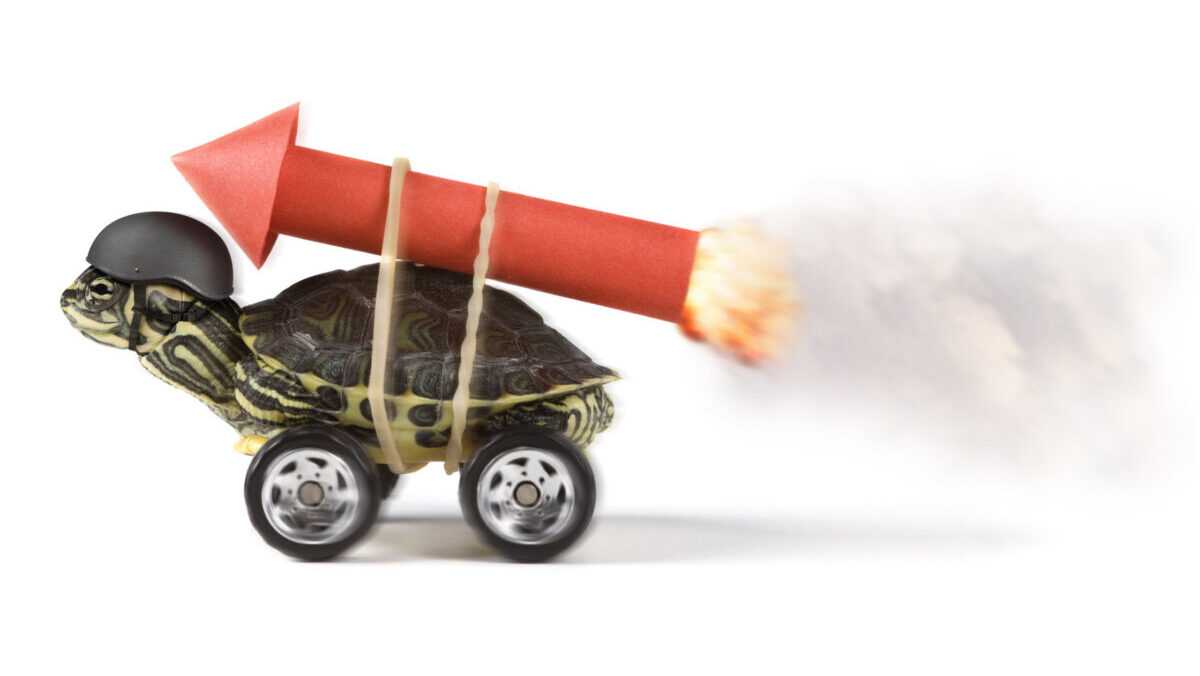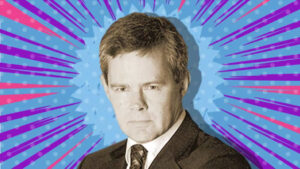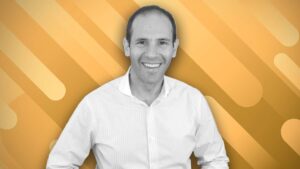Q+A: Perseus Mining’s Jeff Quartermaine on why the $2.5bn African gold miner aims to be a ‘fast tortoise’

Pic: MediaProduction/E+
- Perseus Mining is down 16% YTD despite rolling out its best ever production year of more than 530,000oz in FY23
- Now a regular dividend payer, the company has a massive warchest of US$594 million in cash and bullion and US$300m in undrawn debt to pursue M&A
- But Perseus MD Jeff Quartermaine tells us the focus is also on organic growth
Perseus Mining (ASX:PRU) is one of the great turnaround stories on the ASX.
The West African gold producer’s share price tumbled over two years from 2011 to 2013 after realising, shock horror, that its previously rampaging share price meant it would have to go through and develop the Edikan gold mine in Ghana.
Since February 2013, a new management team led by former CFO Jeff Quartermaine set it on a path to grow into the ASX’s only 500,000ozpa African gold producer and one of the few ASX gold stocks paying reliable dividends.
Now with over a decade of time as CEO under his belt, Quartermaine is faced with the challenge of growing the company further without blowing up the hard-fought gains of the past 10 years.
Perseus shares fell to 22c in December 2013, shortly after a rejig of the life of mine plan at Edikan to deal with high costs in a falling gold price environment.
From that point the miner added the Sissingue and Yaoure mines in Cote d’Ivoire, bringing them online to eventually crack the 500,000ozpa mark in FY23, selling 537,564oz at an all in site cost of US$959/oz. In spite of inflationary pressures felt across the globe, that is well below the cost of production Perseus absorbed in its early years.
While its share price hit a 10-year high of $2.49 in April this year, it is counter-intuitively down almost 16% YTD despite near record gold prices.
That has led to calls from analysts and management alike that the stock is mispriced compared to its Australian peers, especially with US$594m of cash and another US$300m in undrawn debt finance waiting to be deployed on acquisitions.
An unfortunately timed foray into Sudan via the purchase last year of TSX-listed Orca Gold to acquire the Meyas Sand project, shortly before the eruption of a civil war in the African country, probably played a role.
But there are few lower cost gold operators on the ASX or the world.
We caught up with Perseus Mining MD Jeff Quartermaine to talk costs, M&A and where the next growth leg could be for the African gold standout.
You took over as CEO in early 2013 and just after that the stock fell into the low 20 cent range. In terms of the journey that you took to bring that back and turn it into one of Australia’s largest gold miners, what did you think was the key aspect there?
“I think when Perseus was originally conceived the people behind it never really imagined that one day we would be a thriving producer. I think they were mainly focused on exploration in the expectation that if they had an exploration success, then a producing company would come along, take them out, and then they’ll move on to the next thing, which is a model that a lot of people pursue.
“Now, as events turned out, that didn’t occur mainly because the share price ran so strongly in 2010 and I would say that with the benefit of hindsight, we were probably ill equipped to make that transition from exploration, through development into operations.
“Very, very few people actually make it through the gate, as it were, on that journey because it involves quite distinctly different skill sets at each stage. For one reason or another, we managed to make it through the gate and get into production.
“And then we had to really consolidate our existence as an operator and focus on the things that would make an operating company successful. So not only do we have to focus in on the operation itself, but look strategically and say well, being a single mine operator in Africa is a fairly risky position to adopt because not only do you have commodity cycles, but you also have political cycles and we will be in a far better position if we could spread our risk over multiple operations in multiple jurisdictions.
“It did take us a bit of time to get the first operation operating satisfactorily but then once that happened, we were able to move on to develop our second one, which was Sissingue, and then ultimately the third one, which was Yaoure. And of course, we were well on the path to an investment decision on our fourth property, which would be would have been in Sudan, until earlier this year when a war unfortunately broke out in Sudan, which has put those development plans on hold.”
You were on a big upward trajectory until the last couple of years despite producing more gold than ever. Your share price has come off a long way. Do you think that’s sort of an element of mispricing in the market or is there something that you feel that the markets missed?
“We complain about our share price and the like, but we are holding up reasonably well. I think everybody has come off quite some way this year.
“We had a very, very strong run up a year and a half ago or two years ago, and so it was not surprising that we did settle back a bit. I do think though, that having said that there is some mispricing or what I would call mispricing on our stock.
“There’s a number of factors around that and it’s not strictly African either. If we look at our portfolio people would say well, yes, they have a long-life asset in Yaoure but the other two assets are not super long life and people would also make the comment that with our average grade at Edikan being a bit over a gram and Sissingue being a bit more and Yaoure being more, it’s not the highest quality asset portfolio in the world.
“Right now, I think the biggest drag on our share price is the fact that the company seems to be regarded as cum-transaction if I can describe it in that way. We’ve accumulated a vast amount of cash as you know over the last year or so.
“If you add the debt and cash, we’ve got about roughly a billion US dollars available to us to continue the growth of the company. And I do know for a fact that a lot of shareholders are sitting on the sidelines, saying … we want to see what you do with that cash before we come in boots and all.
“They want to make sure that we don’t make a bad decision. And I can understand that reticence because it is very easy to do M&A, but it’s very difficult to do really good M&A, and the landscape is littered with transactions that have lost a lot of shareholder value over a period of time.
“But if we follow our form, they’re going to be very happy with what we do in periods to come and I say that because to date we’ve been quite successful in our M&A transactions.
“If you look at the three that we’ve done, they’ve all been done well, they’ve been well priced, and have added a lot of value to our company, notwithstanding the Orca transaction, which for the moment is sort of in a bit of an abeyance period, but gold’s not going anywhere.
“And over the longer term, that project is going to be an important part of our business. So I think we’ve demonstrated that we have the capacity to transact. And it’s just a case of making sure that when we do hit the go button, that we can do it in a way that will create significant value for shareholders.”
Do you have a line of sight as to when it will be safe to restart exploration and resource drilling at Meyas Sand?
“It’s safe now, I mean we are in the process of getting everything together and resuming drilling. So we’ve got a team of people on the site at the moment who are working on fixing up the camp and the like ready for the drillers to come back.
“And we’ve put in place a bespoke security arrangement. Previously we had a security contractor but as history shows was aligned to one of the combatants, so what we’ve done is we’ve established our own security arrangement including cooperating with the government and the mining police, plus local landowners and our own people.
“So we’ve put that in place to make sure that both assets and people are safe and our drilling contractor Capital Drilling is extremely keen to get back in and so as soon as everything is ship-shape, we will be back in on the ground drilling holes and expanding that resource.
“So I do expect that will happen if not later this quarter, then certainly early next quarter.”
So when it comes to M&A, is it Africa specifically that you’re still looking for the next deal? Or is there a chance that you’d look to diversify elsewhere?
“At the moment we’re focused on Africa. I think looking longer term and we’ve got a strategic planning session coming up, actually next week, where we’ll discuss this sort of thing and say at what point do we start to look further afield from Africa and if we do that where would be comfortable.
“Should we be considering for instance, instead of being a gold pure play, would we be willing to look at polymetallics or have copper in the mix or something like that?
“Depending on those sorts of decisions that could change our focus a little but I would say that operating in multiple timezones is quite challenging for a small company. It’s okay for the very large companies that are very decentralised but for a company of our size operating in multiple timezones would be challenging from a management point of view.
“And the other thing to remember is when we go to a new jurisdiction, we will start at the bottom of the heap in terms of knowing how to operate, who to operate with etc., so you don’t take that decision lightly. So that’s a long winded way of saying for the moment we’ll be focusing on Africa.”
What do you make of the opportunities on offer when you speak about M&A in Africa. I imagine that West Africa would be sort of ideal for you. Are there opportunities there at the right price at the moment?
“We’re not restricting ourselves to West Africa as a company, we do want to maintain a level of diversity in the portfolio and having all the eggs in one basket doesn’t make a lot of sense. So, we are considering other places.
“Places change and what the situation is that exists today wouldn’t be what will exist tomorrow, and the risk-return thing has to has to come into account here. If you take for instance an asset in Burkina Faso, from all reports and I’m speaking second-hand here, because I’m not an expert on Burkina Faso, but from all reports operating in that country is becoming extremely challenging.
“Now that has the impact of depressing the share price of people who are operating there, particularly if they’re pure plays. But at some point in time, you have to say look, the risk is factored into that price. And you’d have to say, this price even though it is risky, we’re willing to get involved.
“Now I’d say at the moment, that probably isn’t the case in terms of Burkina Faso, but it may well be the case in years to come. And the same can be said of just about every jurisdiction. I have my views around some places where I don’t think I’d ever feel safe there, but at a price, you can make yourself safe.
“Similarly, there are places in Africa where we would be enormously comfortable, but the return from the mineral wealth isn’t quite what we need. You’ve just got to strike that balance in between risk and return.”
You spoke about Yaoure, you just had the big life extension there out to 2035. How are you going in terms of finding opportunities to extend the mine life at Edikan and Sissingue as well?
“Really well, actually, at Sissingue we’ve got some pretty good results coming through at the present time. The guys are working on that and we think that will give us a bit of a lift in the mine life but we’ve got to do the homework first. So that is actually quite encouraging for us. We think that more likely than not, there will be several more of those up in that broad area.
“We’ve got three contiguous exploration licenses that we’ve acquired over the last couple of years up there and we’ve hardly scratched the surface. At Edikan we’ve got a significant tract of land that has been not explored at all by professional explorers and miners. The artisanals have certainly been doing their thing on this land for a period of time, but we haven’t had the opportunity.
“The very first target we went after on this tract of land, we discovered the (330,000oz reserve) Nkosuo deposit. When I was on the site a month or so ago talking to the team at Edikan as a group we committed to doing all that we needed to do to extend the life for another 10 years. And that’s a very achievable target in our view.
“And similarly at Sissingue we collectively set ourselves a target of extending the life for another five years and we’re well on the way to that already, but without doing anything too much special so I think the opportunity to increase the life of existing assets is very good. And so investment in organic growth activities is a priority for us.
“And that’s where you actually create the most value because we’ve already invested in the infrastructure so the return on any incremental ounces is very, very high. And so that’s where we’re focusing a lot of attention.”
I’m keen to look at as well the all in sustaining cost side of things, because a lot of the companies in Australia in particular have been dealing with pretty severe inflation on that front. You’re still seeing costs of sort of under US$1,000/oz. Is there something specific about the deposits there that has helped to do that, the operating environment, the cost of labour, or is it something more specific as to how they’ve been managed?
“I would say we work it very hard. We work very hard at identifying ways of keeping your cost base under control, taking costs out of the business. A lot of people will say, oh you’ve got it easy over there because labour costs are lower. Well I can assure you that labour costs are not lower.
“One thing that is different between Australia and Africa is that the turnover of staff is a lot lower, because people in Africa if they get a job in the mining industry, they will do everything within their power to keep that job because they are so much better off than most of their country. In Australia, people are pretty easy about whether they work or whether they don’t, there’s been a lot of government largesse over the years and people are fairly casual about coming and going.
“And that itself introduces incremental costs because first of all, you’ve got to recruit people, and then you’ve got to train them, etc. Our workforce is probably more stable, but it does not come at a lower cost. In fact, if you look at the numbers of people that we employ, we employ far greater numbers than you do in Australia.
“Full employment is the goal of most host countries and they would much rather have a lot of people employed at slightly lower rates then have a fewer number at higher rates unless of course they’re getting something from it themselves.
“So it’s not at all correct to say that we have it easy.
“The other thing I’d point out is that systematically royalty rates in Africa are a lot higher than they are in Australia. And I dare say that in Africa, we also routinely carry a fixed cost for security that you wouldn’t be using in Australia. So there are swings and roundabouts.
“There are some things that are lower cost or better. There are some things that are not and what you need to do — doesn’t matter whether you’re working in Australia or Africa — you’ve got to work really hard, focus on your business, make sure that nothing gets between you and maximising your number of ounces and doing it at the lowest possible cost. That’s what we do.”
You mentioned gold’s not going away. I know there’s been a little bit of pessimism around investing in gold stocks and stocks that are operating in battery metals have taken a lot more focus from investors and media. Where do you see the long term support for gold prices and gold as a commodity of interest?
“I’ve no better idea than anybody, so it’s just an opinion … I think it’s pretty hard to imagine with all the turmoil going on in the world that there’s going to be a rapid pullback in the gold price.
“So I would be expecting that we will see prices at least around current levels for quite a few more years into the future. Now, beyond that who knows what it’s going to do? It could take off big time and I’ve had people making very bold statements around future gold prices, but from our point of view and this sounds a bit trite and I don’t mean it to but we’re a bit agnostic in that regard because we can’t control the gold price.
“What we can control is how much gold we make and what cost we make it at and if we can keep our costs down, then we will stay in business when a lot of people won’t.
“And if you look in the last 12 months, our cost structure was one of the best in the world actually, I think it’s certainly in the bottom 5% and there are a lot of people who were seriously bleeding cash. And that was even at US$1900 an ounce.
“If the gold price was to fall from here, there’s going to be a lot of pain I think in the industry. And that says to us, you better make sure if that happens, you’re well prepared for it by having your cost structure in order.”
Do you have a target about how big you want to get from a production perspective?
“Not particularly. We’re running around the 500,000-odd ounces now and we can maintain that out towards the end of the decade. If we did do M&A arguably you’d be adding a couple hundred thousand ounces on because that’s the sort of scale that we’d be looking at.
“But one of the challenges of doing that is you’ve got to replace it, the reserves and resources are consumed every year.
“You go to a million ounces, you’ve got to replace 1Moz every year if you want to be a sustainable business. And that is a challenge.
“So the idea of growing rapidly is fine for the short term, but how are you going to maintain that into the future is another matter altogether.
“Our approach is probably to … steadily increase and to make sure that every year we add back on to the inventory at least what we take off. I think last year for instance, we actually added more on than we had in previous years.
“But that has been the mantra for the last four or five years, make sure that whatever we deplete, we add back on through organic growth and that will be our focus going forward. It will be something that will probably moderate the pace at which we do grow.
“Someone asked us once ‘do you want to be the tortoise or the hare?’ We said we want to be a fast tortoise, and that’s pretty much right I think.”
Perseus Mining (ASX:PRU) share price today
Related Topics

UNLOCK INSIGHTS
Discover the untold stories of emerging ASX stocks.
Daily news and expert analysis, it's free to subscribe.
By proceeding, you confirm you understand that we handle personal information in accordance with our Privacy Policy.








